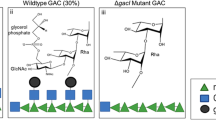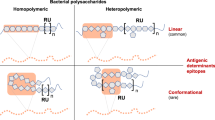Abstract
In previous studies protective antibodies that could facilitate bactericidal killing of Neisseria meningitidis (Nm) serogroup B strains were derived from immunisation with glycoconjugates prepared from O-deacylated lipopolysaccharide (LPS-OH) via direct reductive amination between the reducing end of the oligosaccharide molecule, created by treatment with alkaline phosphatase, and amino functionalities on the CRM197 carrier protein. These glycoconjugates proved difficult to prepare because the presence of amide linked fatty-acyl groups results in glycolipids that are relatively insoluble and aggregate. Therefore, we have examined several strategies to prepare glycoconjugates in order to identify a robust, consistently reproducible strategy that produces glycoconjugates with a high loading of LPS derived oligosaccharides. Initially we used completely deacylated LPS molecules, but lacking phosphoethanolamine (PEtn) from the core OS as the strong basic conditions required to completely deacylate the LPS would modify the PEtn residue. We utilised a squarate linker and conjugated via the reducing end of the carbohydrate antigen following removal of the glycosidic phosphate to amino groups on CRM197, however carbohydrate loading on the carrier protein was low. Glycoconjugates were then produced utilising amidases produced by Dictyostelium discoideum (Dd), which partially remove N-linked fatty acids from the lipid A region of the Nm LPS molecule, which enabled the retention of the PEtn residue. LPS-OH was treated with Dd amidase, the reducing glycosidic phosphate removed, and using a cystamine linker strategy, conjugated to the carrier protein. Carbohydrate loading was somewhat improved but still not high. Finally, we have developed a novel conjugation strategy that targets the amino functionality created by the amidase activity as the attachment point. The amino functionality on the PEtn residue of the inner core was protected via a novel blocking and unblocking strategy with t-butyl oxycarbonyl. A maleimide-thiol linker strategy, targeting lysine residues on the carrier protein did not result in high loading of the carbohydrate molecules, however when we targeted the carboxyl residues we have consistently obtained a high loading of carbohydrate antigens per CRM197, which can be controlled by variation in the amount of activated carbohydrate utilised in the conjugation reaction.











Similar content being viewed by others
References
Moe, G.R., Dave, A., Granoff, D.M.: Epitopes recognized by a non-autoreactive murine anti-N-propionyl meningococcal group B polysaccharide monoclonal antibody. Infect. Immun. 73, 2123–2128 (2005)
Pon, R.A., Lussier, M., Yang, Q.L., Jennings, H.J.: N-Propionylated group B meningococcal polysaccharide mimics a unique bactericidal capsular epitope in group B Neisseria meningitidis. J. Exp. Med. 185, 1929–1938 (1997)
Holst, J., Feiring, B., Fuglesang, J.E., Hoiby, E.A., Nokleby, H., Aaberge, I.S., Rosenqvist, E.: Serum bactericidal activity correlates with the vaccine efficacy of outer membrane vesicle vaccines against Neisseria meningitidis serogroup B disease. Vaccine 21, 734–737 (2003)
Oster, P., Lennon, D., O’Hallahan, J., Mulholland, K., Reid, S., Martin, D.: MeNZB: a safe and highly immunogenic tailor-made vaccine against the New Zealand Neisseria meningitidis serogroup B disease epidemic strain. Vaccine 23, 2191–2196 (2005)
Li, Y., Sun, Y.H., Ison, C., Levine, M.M., Tang, C.M.: Vaccination with attenuated Neisseria meningitidis strains protects against challenge with live meningococci. Infect. Immun. 72, 345–351 (2004)
Gorringe, A.: Can Neisseria lactamica antigens provide an effective vaccine to prevent meningococcal disease? Expert Rev. Vaccines 4, 373–379 (2005)
Pizza, M., Scarlato, V., Masignani, V., Giuliani, M.M., Arico, B., Comanducci, M., et al.: Identification of vaccine candidates against serogroup B meningococcus by whole-genome sequencing. Science 287, 1816–1820 (2000)
Gorringe, A., Halliwell, D., Matheson, M., Reddin, K., Finney, M., Hudson, M.: The development of a meningococcal disease vaccine based on Neisseria lactamica outer membrane vesicles. Vaccine 23, 2210–2213 (2005)
Vermont, C.L., Van Dijken, H.H., De Groot, R., Van Alphen, L., Van Den Dobblestein, G.P.: PorA- specific differences in antibody avidity after vaccination with a hexavalent menB outer membrane vesicle vaccine in toddlers and school children. Vaccine 22, 3008–3013 (2004)
Giuliani, M.M., Adu-Bobie, J., Comanducci, M., Arico, B., Savino, S., Santini, L., et al.: A universal vaccine for serogroup B meningococcus. PNAS 103, 10834–10839 (2006)
Plested, J.S., Makepeace, K., Jennings, M.P., Gidney, M.A., Lacelle, S., Brisson, J.R., Cox, A.D., et al.: Conservation and accessibility of an inner core lipopolysaccharide epitope of Neisseria meningitidis. Infect. Immun. 67, 5417–5426 (1999)
Plested, J.S., Harris, S.L., Wright, J.C., Coull, P.A., Makepeace, K., Gidney, M.A.J., et al.: Highly conserved Neisseria meningitidis inner-core lipopolysaccharide epitope confers protection against experimental meningococcal bacteremia. J. Infect. Dis. 187, 1223–1234 (2003)
Cox, A.D., Zou, W., Gidney, M.A.J., Lacelle, S., Plested, J.S., Makepeace, K., et al.: Candidacy of LPS-based glycoconjugates to prevent invasive meningococcal disease: developmental chemistry and investigation of immunological responses following immunization of mice and rabbits. Vaccine 23, 5045–5054 (2005)
Pavliak, V., et al.: Neisseria meningitidis LOS conjugate vaccine against meningococcal disease. 14th IPNC, Milwaukee, USA (2004)
Gidney, M.A.J., Plested, J.S., Lacelle, S., Coull, P.A., Wright, J.C., Makepeace, K., et al.: Development, characterisation and functional activity of a panel of specific monoclonal antibodies to inner core lipopolysaccharide (LPS) epitopes in Neisseria meningitidis. Infect. Immun. 72, 559–569 (2004)
Mackinnon, F.G., Cox, A.D., Plested, J.S., Tang, C.M., Makepeace, K., Coull, P.A., et al.: Identification of a gene (lpt-3) required for the addition of phosphoethanolamine to the lipopolysaccharide inner core of Neisseria meningitidis and its role in mediating susceptibility to bactericidal killing and opsonophagocytosis. Mol. Microbiol. 43, 931–943 (2002)
Jäkel, A., Plested, J.S., Hoe, J.C., Makepeace, K., Gidney, M.A.J., Lacelle, S., et al.: Naturally-occurring human serum antibodies to inner core lipopolysaccharide epitopes of Neisseria meningitidis protect against invasive meningococcal disease caused by isolates displaying homologous inner core structures. Vaccine 26, 6655–6663 (2008)
Westphal, O., Jann, K.: Bacterial lipopolysaccharide. Methods Carbohydr. Chem. 5, 88–91 (1965)
Smith, P.K., Krohn, R.I., Hermanson, G.T., Mallia, A.K., Gartner, F.H., Provenzano, M.D., et al.: Measurement of protein using bicinchoninic acid. Anal. Biochem. 150, 76–85 (1985)
Dubois, M., Gilles, K.A., Hamilton, J.K., Rebers, P.A., Smith, F.: Colorimetric method for determination of sugars and related substances. Anal. Chem. 28, 350–356 (1956)
Claviez, M., Pagh, K., Maruta, H., Baltes, W., Fisher, P., Gerisch, G.: Electron microscopic mapping of monoclonal antibodies on the tail region of Dictyostelium myosin. EMBO J. 1, 1017–1022 (1982)
Sawardeker, D.G., Sloneker, J.H., Jeanes, A.: Quantitative determination of monosaccharides as their alditol acetates by gas liquid chromatography. Anal. Chem. 37, 1602–1604 (1965)
Cox, A.D., Li, J., Brisson, J.-R., Moxon, E.R., Richards, J.C.: Structural analysis of the lipopolysaccharide from Neisseria meningitidis strain BZ157 galE: localisation of two phosphoethanolamine residues in the inner core oligosaccharide. Carbohydr. Res. 337, 1435–1444 (2002)
Laemmli, U.K.: Cleavage of structural proteins during the assembly of the head of bacteriophage T4. Nature 227, 680–685 (1970)
Pozsgay, V., Chu, C., Pannell, L., Wolfe, J., Robbins, J.B., Schneerson, R.: Protein conjugates of synthetic saccharides elicit higher levels of serum IgG lipopolysaccharide antibodies in mice than do those of the O-specific polysaccharide from Shigella dysenteriae type 1. PNAS 96, 5194–5197 (1999)
Rosner, M.R., Verret, R.C., Khorana, H.G.: The structure of lipopolysaccharide from an Escherichia coli heptose-less mutant. III. Two fatty acid amidases from Dictyostelium discoideum and their action on lipopolysaccharide derivatives. J. Biol. Chem. 254, 5926–5933 (1979)
Acknowledgements
We thank Perry Fleming for bacterial growth and Jacek Stupak, Lisa Morrison and Dr. Jianjun Li for mass spectrometry. This work was supported by Novartis Vaccines. We thank Drs. E. Richard Moxon, Paolo Costantino, Francesco Berti and Wei Zou for helpful discussions.
Author information
Authors and Affiliations
Corresponding author
Rights and permissions
About this article
Cite this article
Cox, A.D., St. Michael, F., Neelamegan, D. et al. Investigating the candidacy of LPS-based glycoconjugates to prevent invasive meningococcal disease: chemical strategies to prepare glycoconjugates with good carbohydrate loading. Glycoconj J 27, 401–417 (2010). https://doi.org/10.1007/s10719-010-9287-0
Received:
Revised:
Accepted:
Published:
Issue Date:
DOI: https://doi.org/10.1007/s10719-010-9287-0




